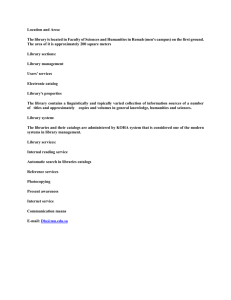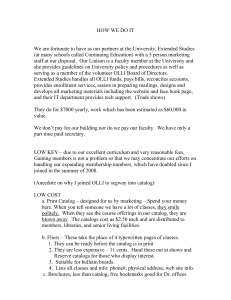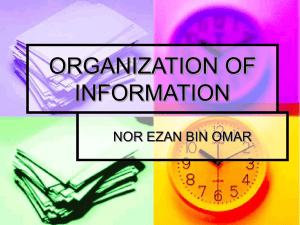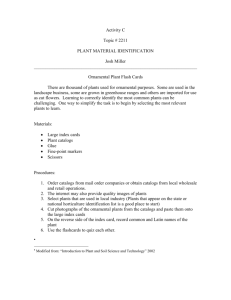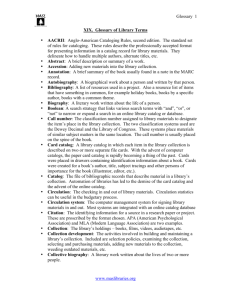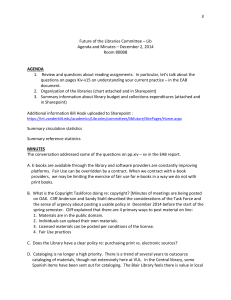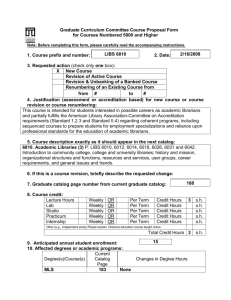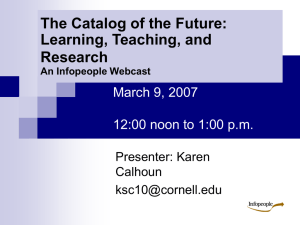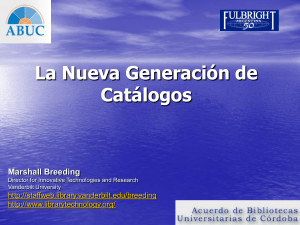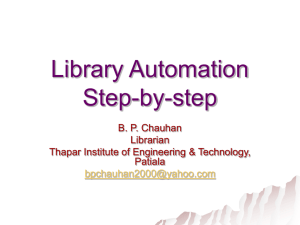Enhancing Automated Library Catalogs: PowerPoint Presentation
advertisement
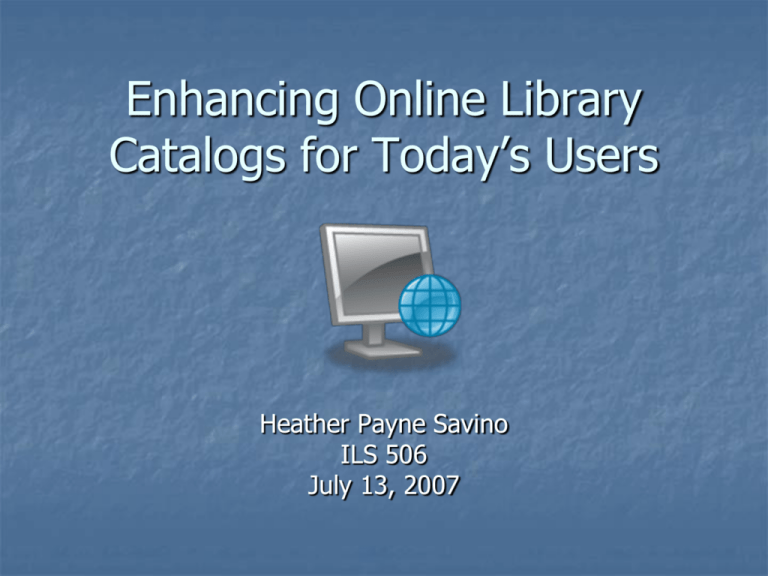
Enhancing Online Library Catalogs for Today’s Users Heather Payne Savino ILS 506 July 13, 2007 Introduction In the digital age, users are increasingly relying on online public access catalogs (OPACs) as their primary means of browsing library collections, locating and selecting materials. Internet sites such as Google and Amazon.com have influenced users’ expectations. Although the growth of automated catalogs has resulted in many improvements over card catalogs, many OPACs retain the traditional format of the card catalog. OPACs must be improved to meet today’s users’ needs and expectations. Ease of Use Needs Users prefer ease of use over quality Library catalogs are perceived as difficult to use Solutions Easy-to-use interfaces One-stop searching Simple instructions Context-sensitive, interactive help Relevancy Ranking Needs Users expect the most relevant hits to come to the top Dealing with information overload: most users will not go beyond the first page of results Solutions Ranking by relative position of terms, the number of occurrences of terms, proximity of multiple search terms to each other etc. Assigning more weight to terms found in subject headings, classification captions, tables of contents and summaries Enriching Content Needs Users need enriched content to help find and evaluate materials Additional content improves access and circulation Solutions Must include summaries, tables of contents, cover art, reviews and excerpts Provision of full-text materials through catalog Remote Browsing Needs Ability to browse library collections through the OPAC Solutions Inserting hyperlinks which will create new searches for related materials based on criteria such as author, subject heading or series title Allowing users to click on call numbers to see books with similar classifications Providing an Information Gateway Need Ability to access both library resources and external resources Solutions Including internet results along with OPAC results Cataloging internet resources Creating union catalogs with other libraries Improved Cataloging Need Outmoded cataloging practices impede patrons’ ability to use and understand library catalog records Solutions Make all access points equal Remove library jargon from catalogs Make works in collections and anthologies accessible Banish inversion of name and subject headings Use multiple classification numbers and tagging to increase access Improved Search Capabilities Need Improved search capabilities to help improve access Solutions Advanced search features like the ability to save and reuse search criteria and results, combine queries etc. Qualification cataloging (searching on qualifications such as the particular discipline or format) Faceted navigation/clustering (separating results into categories that users can click on to narrow their search) Library 2.0 and Personalization Need Incorporation of Library 2.0 concepts: interactive, multimedia, personalized services Solutions User accounts that keep track of users’ favorite authors and subjects, enabling librarians to make recommendations and notify users when the library acquires new materials that match their interests Allowing users to add comments and reviews to bibliographic records Allowing users to tag items in the catalog Conclusion With so many users happy to turn to internet search engines for their information needs, library catalogs will have to offer more to attract patrons. This means incorporating better content, improving cataloging, access and search capabilities, creating easyto-use interfaces, helping users find what they need through relevancy ranking, allowing remote browsing, and allowing users to personalize the OPAC to their needs. The OPAC of the future must be a portal to the world of information, helping users find the information they need wherever it can be found. Sources Consulted Benson, Amy, & Favini, Robert. (2006). Evolving web, evolving librarian. Library Hi Tech News, 23(7), 18-21. Breeding, Marshall. (April 2007). Thinking about your next OPAC. Computers in Libraries, 27(4), 28-30. Byrum, John D., Jr. & Williamson, David W. (March 2006). Enriching traditional cataloging for improved access to information: Library of Congress Tables of Contents Projects. Information Technology and Libraries, 25(1), 4-11. Coyle, Karen. (January 2005). Catalogs, card – and other anachronisms. The Journal of Academic Librarianship, 31(1), 60-62. Harmsen, Bernd. (2000). Libraries and the web: Adding value to webOPACs. The Electronic Library, 18(2), 109-113. Hoffman, Herbert. (May/June 2000). Contents or container?: Priorities for the online catalog. Public Libraries, 39(3), 132-133. Hughes, Jane E. (May 2001). Access, access, access!: The new OPAC mantra. American Libraries, 32(5), 62-64. Librarything.com. (2007) Retrieved July 5, 2007 from http://www.librarything.com/concepts. Maness, Jack M. (2006). Library 2.0 theory: Web 2.0 and its implications for libraries. Webology, 3(2), Article 25. Retrieved September 27, 2006 fromhttp://www.webology.ir/2006/v3n2/a25.html. Markey, Karen. (January/February 2007). The online library catalog: Paradise lost and paradise regained? D-Lib Magazine, 13(1/2). Retrieved July 2, 2007 from http://www.dlib.org/dlib/january07/markey/01markey.html. Mi, Jia & Nesta, Frederick. (2006). Marketing library services to the net generation. Library Management, 27(6/7), 411-22. Novotny, Eric. (November 2004). I don’t think I click: A protocol analysis study of use of a library online catalog in the internet age. College & Research Libraries, 65(6), 525-537. O’Reilly, Tim. (2005) What Is Web 2.0: Design Patterns and Business Models for the Next Generation of Software. Retrieved September 8, 2006 from http://www.oreillynet.com/lpt/a/6228. Ortiz-Repiso, Virginia & Moscoso, Purification. (June 1999). Web-based OPACs: Between tradition and innovation. Information Technology and Libraries, 18(2), 68-77. Shirky, Clay. (2005). Ontology is overrated: Categories, links, and tags. Clay Shirky’s Writings About the Internet. Retrieved July 5, 2007 from http://www.shirky.com/writings/ontology_overrated.html. Suster, Mark. (November/December 2006). Folksonomy. AIIM E-Doc Magazine, 20(6), 20-21. Tennant, Roy. (June 15, 2004). Enriching the catalog. Library Journal, 129(11), 33.
